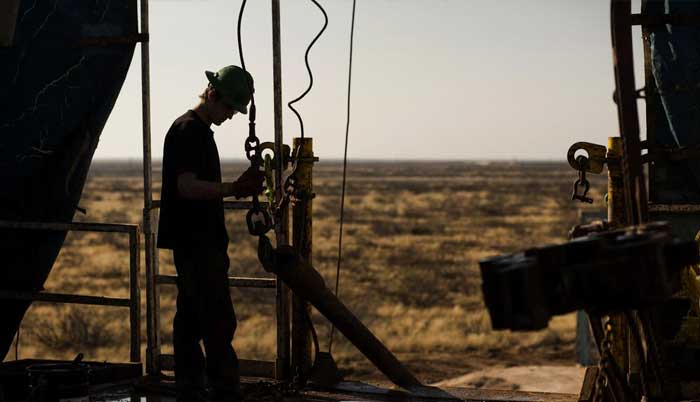![]() Home > World Business
Home > World Business
Oil's Path To $70 Defied Pressures That Still Threaten Prices

A worker waits to connect a drill bit on Endeavor Energy Resources LP's Big Dog Drilling Rig 22 in the Permian basin outside of Midland, Texas, U.S., on Friday, Dec. 12, 2014. Of all the booming U.S. oil regions set soaring by a drilling renaissance in shale rock, the Permian and Bakken basins are among the most vulnerable to oil prices that settled at $57.81 a barrel Dec. 12. With enough crude by some counts to exceed the reserves of Saudi Arabia, they’re also the most critical to the future of the U.S. shale boom. Photographer: Brittany Sowacke
![]() January 13th, 2018 | 09:51 AM |
January 13th, 2018 | 09:51 AM | ![]() 1339 views
1339 views
BLOOMBERG.COM
Oil’s rise to $70 a barrel for the first time in three years had clear triggers as supplies tighten and demand climbs, yet it still surprised many traders because there were so many reasons for prices to falter.
Those bearish pressures are still in place, and could make it tough for crude to hold onto its gains.
Stockpiles Grow Again
One thing the major forecasters agree on is that, after shrinking dramatically in 2017, oil stockpiles should be starting to build up again.
Global oil demand dips seasonally as the need for winter fuels recedes, and data from both OPEC and the International Energy Agency suggest that will tip the market back into surplus in the first half of this year. Inventories will shrink again in the second half, their data indicate.
While weekly U.S. data shows that crude inventories are declining, it’ll be another couple of months before a clear picture for other consumers emerges.
Disruptions Fade
Supply disruptions boosted prices in early December, when a critical North Sea pipeline was halted, and at the end of the month when a pipeline explosion curbed flows from OPEC member Libya.
The suspension of the Forties Pipeline System -- one of the North Sea’s biggest disruptions since the 1980s -- was resolved by the end of last month, and repairs on the conduit to Libya’s Es Sider terminal were completed about the same time. Yet the resolution of both outages did little to push prices lower.
Risks to production still remain, though, with Goldman Sachs Group Inc. considering Venezuela and Nigeria to be among the most vulnerable.
Political Dangers Recede
Political risks in major oil producers also bolstered the market, yet as these stabilized or receded prices still stayed strong.
A corruption crackdown by Saudi Arabia’s Crown Prince Mohammed bin Salman in early November sparked concerns the world’s biggest oil exporter would suffer a backlash and instability that didn’t materialize.
An even bigger boost came last month when Iran, OPEC’s third-largest producer, faced its biggest street protests in almost a decade amid discontent with the country’s economic stagnation. Though these didn’t escalate or threaten oil facilities, crude prices didn’t fall back.
Another risk to Iranian exports appears to have been dodged as U.S. President Donald Trump backs away from tearing up an accord on Iran’s nuclear program, which would have slapped American sanctions back on oil shipments.
Source:
courtesy of BLOOMBERG
by Grant Smith
If you have any stories or news that you would like to share with the global online community, please feel free to share it with us by contacting us directly at [email protected]